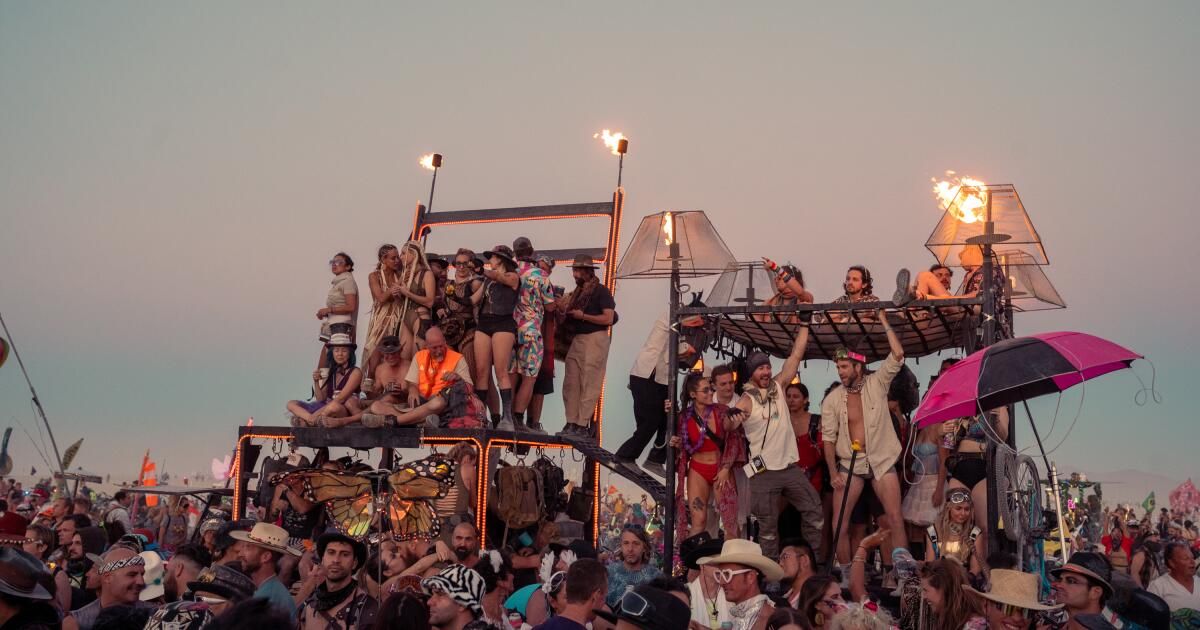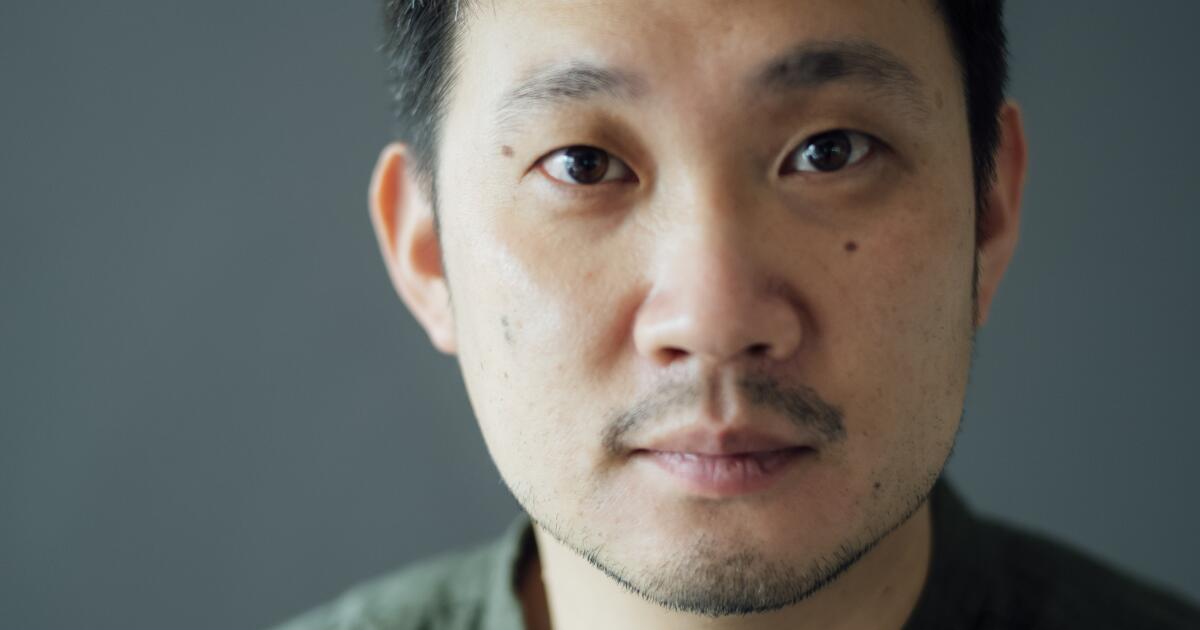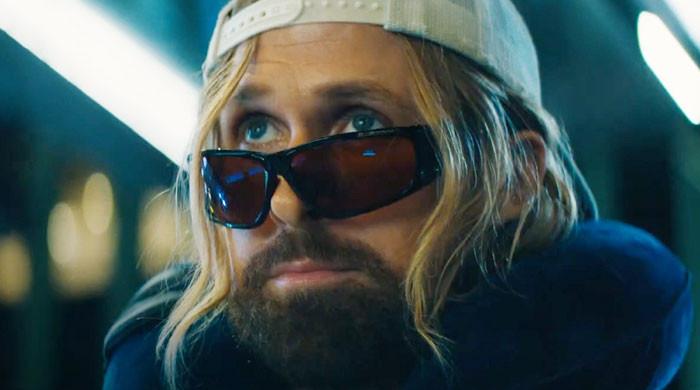Burning Man is a real drag. The average participant must be completely self-sufficient and buy enough food, water and supplies to survive at least seven days in a barren, dusty desert where the only thing for sale is ice. It's a seemingly endless cycle of packing, loading, unloading, unpacking, building and assembling, only to break down, repack, reload, unload and unpack again. Meanwhile, your body and brain are drained of fluids and serotonin, while everything you carry accumulates a layer of corrosive alkaline dust that follows you home.
For those who choose to run a massive themed camp of 300+ people, it's like they're preparing for the 10-year Trojan War. A common assumption made by those unfamiliar with the Burning Man ethos is that Black Rock City's seven square miles of elaborate art installations, sculptures, stages, themed camps, and art cars are created by a production overlord like Goldenvoice or Insomniac. The reality is that most of Burning Man is dreamed up, designed, built, and paid for by its resourceful, scrappy attendees, most of whom are No backed by tech moguls or billionaires.
Much like Burning Man’s humble beginnings at Baker Beach in the 1980s, Frothville began as a small band of “Frothin’ Weirdos” (their original moniker for the camp) whose claim to fame was their sunrise rib-and-champagne party with tunes provided by veteran Burner Random Rab. As the years progressed, so did the Frothin’ Weirdos, absorbing several camps and eventually morphing into Frothville. After a successful conglomeration in 2023, this year’s camp leaders Jesse Albright, Gus Irwin, and Zachary Cotler decided to take on their most ambitious project yet.
Along with a 50-foot wedding dome and various back-of-house props, Frothville’s main attraction was a five-story rectangular tower known as “The Gallery,” which sat on the Esplanade, Burning Man’s busiest thoroughfare. Wrapped in white vinyl, it featured psychedelic projections on its exterior and could be seen from across the playa—a convenient beacon as you made your way through the night in a state of confusion. In addition to hosting musical acts including Griz, Diplo, Frances Mercier, Maddy O’Neal, Monolink, and Random Rab, each level of the tower featured ornate nooks and crannies in which to dance, lounge, snuggle, sway, and drink. As you climbed the labyrinthine scaffolding stairs, you eventually reached the open top level where you were treated to a 360-degree view of Burning Man, which, especially at night, was a visual mashup of swirling lights and hazy fire.
Many of the camp leaders and their support teams had been working on this project for more than 40 hours a week for eight months, nearly doubling those hours in the weeks leading up to the event that began in late August. With an original budget of $440,000, the actual expenditure was closer to $650,000, which was raised by us, the campers, as well as donations through The Gallery Foundationa nonprofit organization that offers year-round support to both emerging and established artists. While the gallery’s impressive feat of construction drew awe from visitors, business behind the scenes was complicated.
Frothville's main attraction, a five-story rectangular tower known as “The Gallery.”
(Najera Miles)
My second year with Frothville was a very different experience than last year, and not just because of the biblical rain that splash headlinesThe 2023 edition was more intimate, and a deeper sense of connection and camaraderie was generated among fellow campers, despite hosting over 200 people. There was a joy and affability that was missing this year and was instead replaced by tension, haughtiness, indifference, and outright rudeness—a sentiment I heard from several fellow campers, both old and new. I made many attempts to help and befriend unfamiliar faces, and was often met with biting disrespect, distant dismissal, or condescending remarks. There were several people who didn’t lift a finger and skipped their work shifts, forcing other campers to step up and keep things going. It was jarring and incongruous, especially since the Burning Man community has long been a source of love, connection, and communal effort, particularly within Frothville.
Problems began early on, as rain and wind slowed production and people who were supposed to help during construction week were unable to secure early entry passes, leaving them stranded in nearby towns. Construction on the tower continued long after opening day, as attendees arrived expecting performances by artists like Treavor Moontribe and instead found a construction site—a frequent occurrence throughout the playa. Scheduled work shifts were continually delayed and rearranged, leading to confusion among campers about how and when to contribute (also a frequent occurrence). While some of us found ways to help, others took it as an opportunity to shirk their responsibilities. However, those of us who showed up united and handled matters did so with aplomb, shots of liquor, a couple near-death experiences, and belly laughs. That’s Burning Man.
What was initially considered a visionary achievement and an epic gift to Black Rock City soon became a source of contention, with camp leaders and builders often left frowning and defeated. Near the middle of the week, when the tower was finally operational, I saw flashes of joy and satisfaction on the faces of those who literally poured their blood, sweat, and tears (there were a few minor injuries) into this project. Some of those with whom I had had negative interactions were all hugs and smiles as the weight of safely building a giant structure to a deadline was lifted from their shoulders. The mission, despite its imperfections, obstacles, and delays, was accomplished, and the thousands of attendees who enjoyed its offerings were none the wiser about its demanding beginnings.
There were plenty of highlights, like the extravagant trapeze artists and fire dancers that livened up our dance floor. A steady stream of top-notch musicians drew people from all corners of the playa, while friends from other camps were left awestruck by the size and spectacle, not thinking about how it was accomplished. Despite the stressful undercurrent that ran through the camp, there was plenty to be thankful for, aside from the brilliant, badass, talented people behind it all who I am lucky enough to call friends. Once again, that's Burning Man.
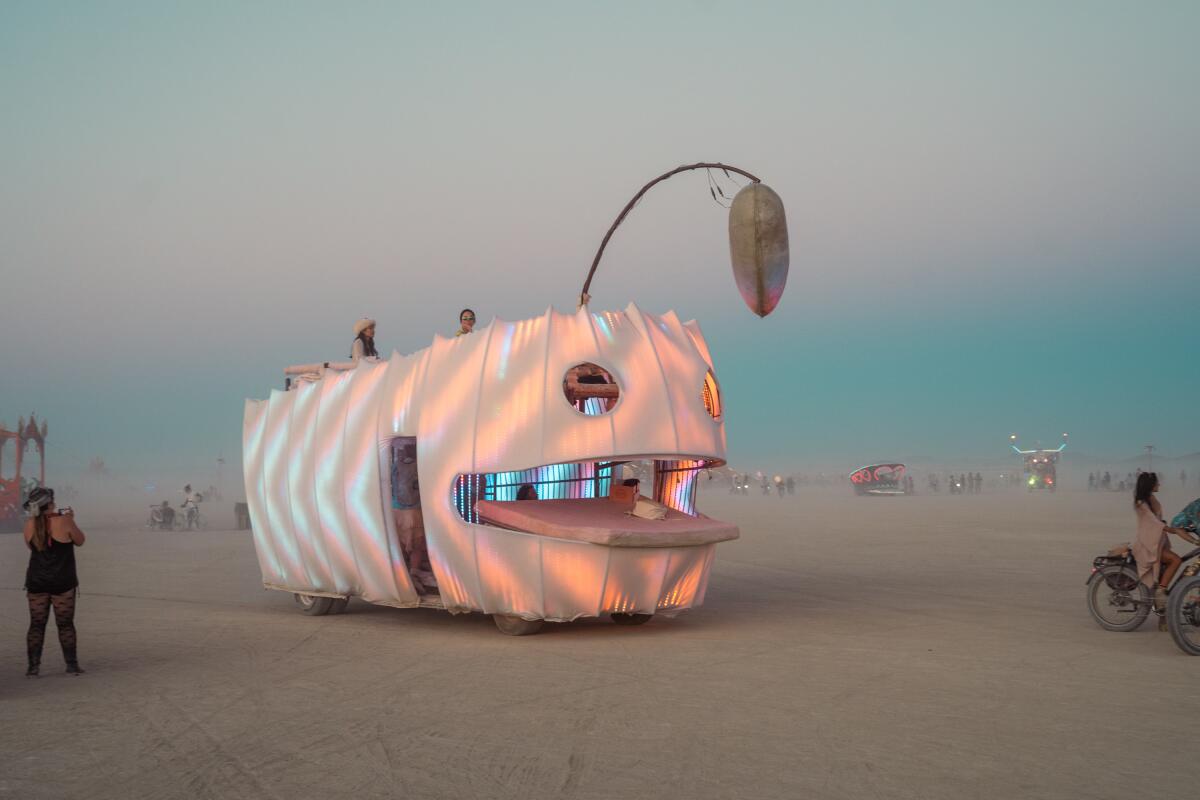
DIY freewheel structure at Burning Man.
(Najera Miles)
After last year’s muddy disaster, the BRC deities blessed us with a week of idyllic weather that offered little dust, warm days, and cool nights. But just when we thought we had avoided another weather event, a white dust storm darkened the once-blue sky on Sunday, September 1, the final day of Burning Man.
“I felt like Vesuvius was spewing dust and we were going to be buried in ash like Pompeii,” says Victoria Cotler, Zachary’s partner, who held her wedding at our campground’s wedding venue. Not only were conditions so grim that the flames from the burning temple dimmed to an eerie, pulsating glow, but dismantling of the tower—along with the wedding dome and other structures at the back of the house—was delayed. The exodus became a dangerous trail of taillights flickering through the dust like dying fireflies, and campsites across the beach feared they would be stuck until the end of the week.
According to Jesse Albright, the leader of Frothville, about 100 people pledged to help with repairs, and as of Tuesday, September 3, only 15 remained. This skeleton crew worked more than 20 hours a day in dangerous, windy conditions to get the camp up and live up to one of Burning Man’s most imperative principles: “leave no trace.” Disappointed, exhausted, and disheveled, Albright sent a Hail Mary to the Frothville WhatsApp thread, asking us to donate money to hire workers. While not ideal, it’s an understandable plea, as they were facing a week-long delay with dwindling supplies, hands, and morale. Shortly after his message was sent, donations began to pour in. For those of us who paid to leave on Sunday due to work and other life commitments, it was a way to contribute and ease the guilt of not being out in the dust with our struggling strike crew.
This is what it takes to build a giant theme camp. Nothing is easy, nothing is quick. One must face disappointment and failure, but also bask in the warmth of hard-earned victories. While Burners are typically of a higher caliber when it comes to civic responsibility and community effort, they are still human, which means that error is inevitable, especially when you place more than 60,000 of them in outlandish circumstances. However, where some relationships were tested and ultimately ended, others were strengthened. By Wednesday, September 4, the tower was completely disassembled and the final disassembly tasks were within reach. After surviving such an excruciating adventure, the question on many people’s minds is: was it worth it? According to Cotler, yes. “Well, we’re masochists, aren’t we?” he jokes. “Yes, of course it was worth it and we would do it again and again because that's Burning Man. The art of a great Burning Man camp is the people who are in it.”
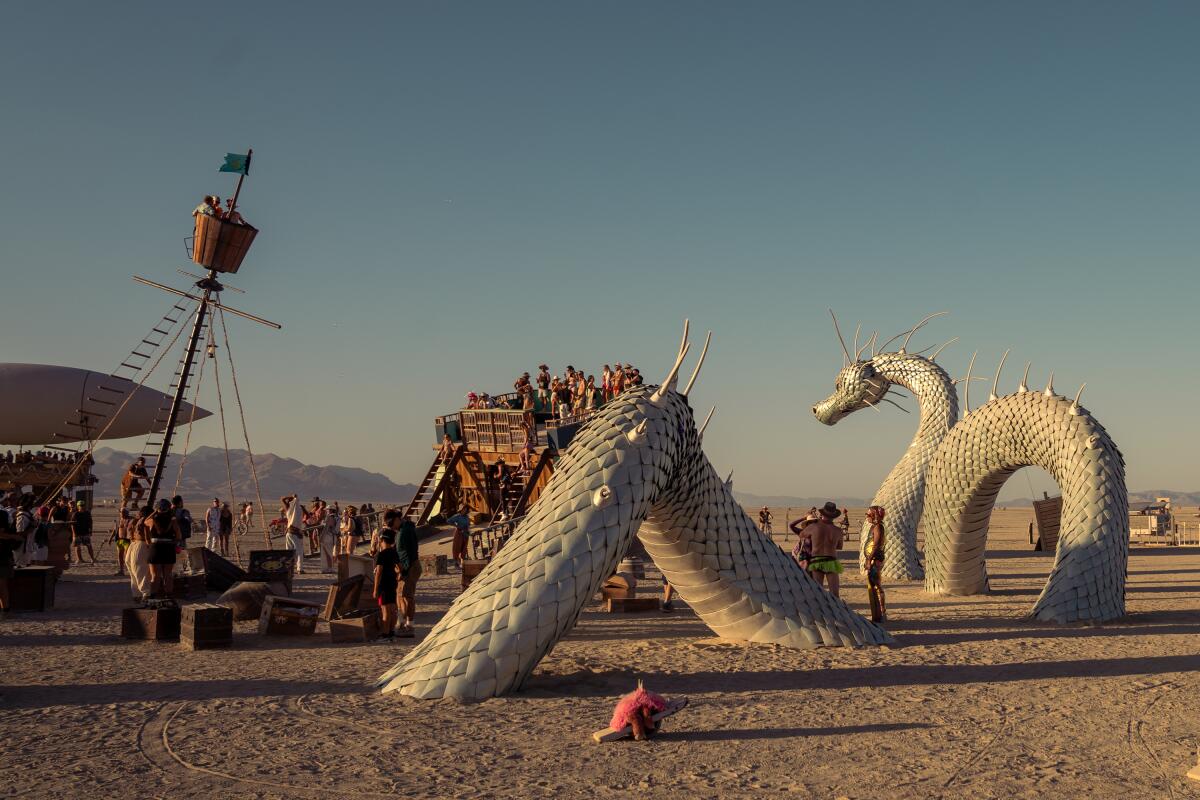
DIY structure at Burning Man.
(Najera Miles)
There is nothing perfect about Burning Man. There is manual labor and gallons of sweat involved. Portable toilets are inevitable, not an option, and the likelihood of injury is high. Plans are sabotaged, schedules are pointless, and expectations are a waste of time. You can have a mental breakdown and threaten to leave into the sunset and then be ecstatic on an art car at midnight. You can commit to an overly ambitious project that may have caused conflict, struggle, and upset, but in retrospect, it will be fondly remembered as an epic creation that evokes happiness while overcoming adversity. If you are able to find joy in the midst of hardship, you are doing well.
“We have to accept that it’s not perfect,” Victoria says. “It’s not about us. We had to strip away our egos and realize that we came together to share something beautiful, and that’s enough. No matter what’s going on behind the scenes, we have to go out into the world with a smile and be those leaders. Even if this was horrible, even if it was stressful, let’s be thankful and happy for the greater good of the community.”

